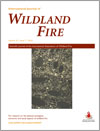International Journal of Wildland Fire
Volume 25
Number 7 2016
Climate and society are changing and these changes are likely to affect factors important to overall wildfire activity, including aggregate fuels distributions, ignition sources and rates, fire spread and suppression. We evaluated how these changes, occurring from 2011 to 2060, could affect wildfire area burned in the south-eastern US.
We show that various drivers impact spatiotemporal differences in burned area and fire frequency in African savanna. Precipitation amount positively influences the burned area in the following dry season. At finer spatial scales, human-made structures such as boreholes and fences strongly affect heterogeneity in fire event distribution. Vegetation morphology and land use are significant predictors of fire events. Use of spatial models that account for spatial autocorrelation dramatically improve model fit to data.
Fire regimes that reduce greenhouse gas emissions provide economic benefit to land owners through carbon markets and quantifying ancillary biodiversity benefit will provide added value through voluntary markets. This study finds that more research is required to quantify the co-benefits for terrestrial fauna in northern Australia.
Knowledge of invertebrate responses to fire is often hampered by taxonomic resolution. We used DNA to examine the impact of fire severity on terrestrial amphipod assemblages. The diversity of these important detritivores has been underestimated, but populations of common species have recovered 3 years following severe bushfire, despite limited dispersal capabilities.
We assessed the degree to which Landsat-derived spectral indices and additional ancillary data can be used to classify canopy mortality when compared with aerial-photographic interpretation for 10 fires in Alberta and Saskatchewan, Canada. The results suggest that models based on three and two mortality classes can be used to map historical fire patterns in a cost-effective manner to support management decisions.
When studied using reflectance microscopy, charcoals are capable of reflecting variable amounts of light from their surface. We show that the most reflective charcoals form as fires transition from flaming to smouldering. Reflectance may therefore have the potential to provide quantitative information relating to surface heating following wildfire events.
This study provides mean squared diameter estimates for fine woody fuels in ponderosa pine forests of Colorado and New Mexico under different management scenarios for use in fuel load estimation with the planar intersect technique. Analysis showed that similarly accurate estimates could be produced from as few as 35 samples.
The causes of wildfire ignitions vary regionally and seasonally in southern France. Ignitions resulting from negligence and accidents are more frequent in urban areas and during summer, intentional ignitions are more frequent in pastures and ignitions resulting from professional negligence are more frequent in hinterlands from autumn to spring.
Protection of people from forest fires demands a thorough understanding of the dangerous situations faced during emergencies. This study sheds light on these situations by analysing the circumstances under which 208 forest fire-related deaths occurred in Greece. Findings identified specific factors and conditions that can increase the risk of fatalities during a forest fire in the country.




